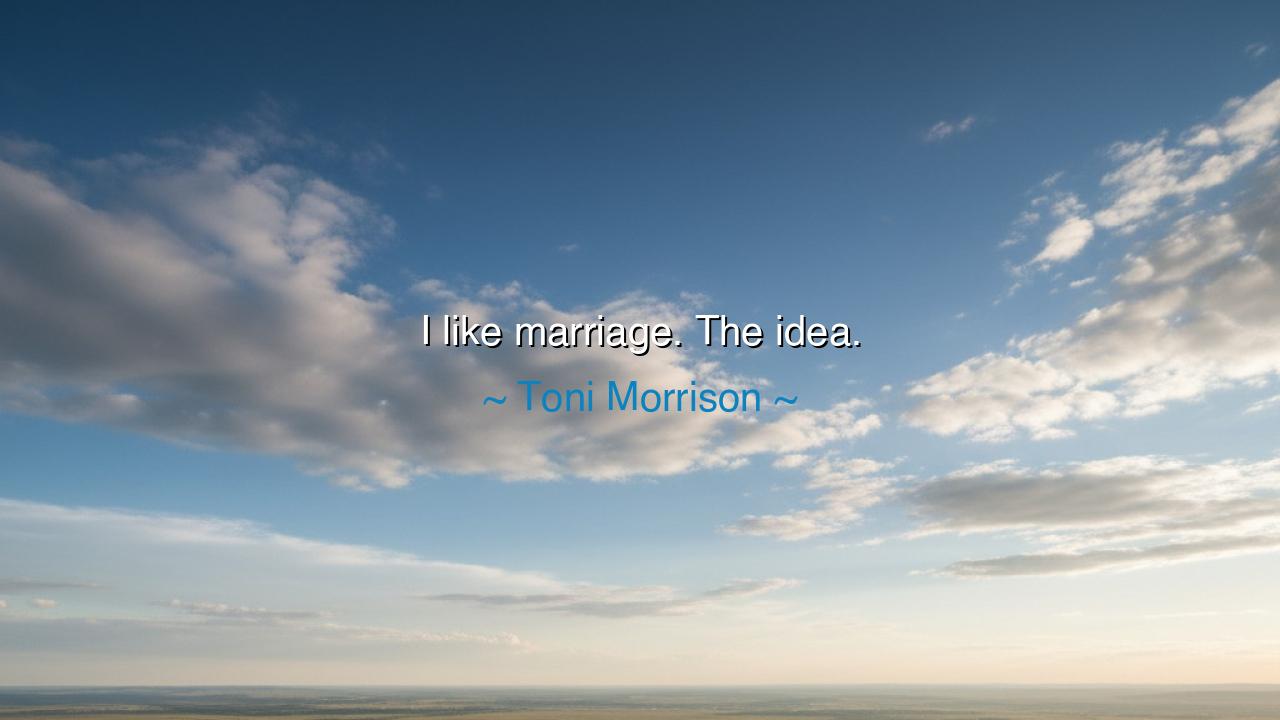
I like marriage. The idea.






In the timeless dance of human relationships, there is one institution that has long been central to our understanding of love, commitment, and society—marriage. Yet, as Toni Morrison so simply but profoundly states, "I like marriage. The idea." With these words, Morrison reflects not just on the institution itself, but on the ideal of marriage—the vision we hold of it, often untarnished by the reality of its complexities. Marriage, in the abstract, is a symbol of union, of partnership, of mutual understanding, and of society’s structure. It is a dream of a future built together, a commitment to stand side by side in the face of life's inevitable challenges.
To understand the essence of Morrison’s words, we must look back to the ancient world, where marriage was not just a personal bond, but a social contract. In Greece, the Athenians viewed marriage as essential to the continuation of the city-state. It was through marriage that the future of the community was secured, for children were the living extensions of the polis. However, while the Greeks revered marriage as a necessary structure, many of their philosophers and writers, such as Socrates and Aristophanes, were deeply skeptical of its idealized form. In their reflections, marriage was often portrayed as something more complicated—a tension between the ideal of companionship and the realities of social and personal expectations.
Rome, too, placed great importance on marriage, but for reasons that were often more practical than romantic. The Romans viewed marriage as a key element in maintaining family lineage and ensuring the continuation of one’s name and honor. Cicero, the great orator, often wrote about marriage, seeing it as a foundation of the Roman family. Yet, his reflections on the subject were often marked by a pragmatic, rather than an idealistic, lens. Cicero’s writings offer a contrast to Morrison’s sentiment, as they show how the ideal of marriage often collides with the pragmatic realities of society, power, and personal desires. Morrison, however, asks us to consider the ideal, the notion of marriage as a vision, a hope for connection, understanding, and unity.
In medieval times, marriage was often arranged, based on family alliances and inheritance rather than love. Yet, in the Renaissance, we see a shift in the way marriage was perceived. Think of the great artists and thinkers of the time, such as Shakespeare, whose works often reflect the complexity of love and marriage. His plays, such as The Taming of the Shrew and Much Ado About Nothing, depict the ideals of romantic unions, but also reveal the tensions and struggles that come with them. Morrison’s words can be seen as a modern echo of this same tension—the idea of marriage, as something that promises connection and fulfillment, is often much easier to conceive than to live out.
Consider the story of Elizabeth Barrett Browning, the renowned poet whose marriage to Robert Browning defied the norms of her time. Elizabeth, deeply isolated due to her health, and Robert, an up-and-coming poet, represented the romantic ideal—a union based on mutual respect, love, and intellectual equality. Their marriage was not only a personal partnership but a symbol of the possibility of a union based on shared values and personal understanding. Yet, even within their deep connection, the realities of their individual circumstances—her health, his career—made marriage difficult at times. Elizabeth’s life and love show us that while marriage may be an ideal, it is also a challenge, filled with moments of joy and frustration, expectation and disappointment.
The lesson of Morrison’s words is clear: marriage—like any ideal—is something we aspire to, something we dream of, but it is also something that must be lived in its full complexity. Marriage is not merely about finding the perfect partner or living up to a cultural ideal. It is about the work, the struggles, and the rewards that come when two people choose to build a life together, despite the imperfections of each. The ideal of marriage can drive us to connect, to share, and to build something greater than ourselves, but we must also accept that the reality will always fall short in some ways. The tension between the two—the ideal and the real—is where the deepest lessons of love and commitment are learned.
In our own lives, we must remember that the ideal is something to strive for, but it is the real moments—the imperfect, the challenging, the human—that truly define the strength of our bonds. Let us embrace the idea of marriage—whether it be between partners, friends, or communities—but let us also accept that the challenges along the way are the very essence of what it means to love. Let us not be disillusioned by the gap between the ideal and the real, but let us learn to love and live in the spaces where the two can merge. In this, we find the true beauty of connection, the true heart of marriage—an ideal that lives within the reality of human life.






AAdministratorAdministrator
Welcome, honored guests. Please leave a comment, we will respond soon